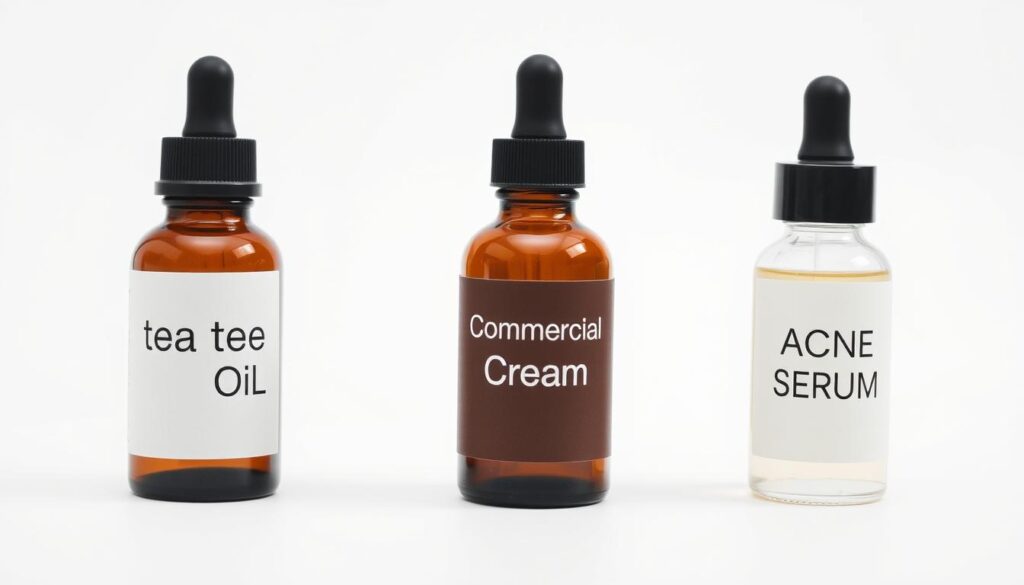Tea Tree Essential Oil: How To Soothe Acne With This Powerful Oil
Dealing with tough acne can be really tough. But, nature has a strong solution: tea tree essential oil. For centuries, Aboriginal healers used it to treat skin problems and fight off bacteria.
Tea tree essential oil comes from the Melaleuca alternifolia tree, found only in Australia. Its strong healing powers make it a big deal for natural skincare. If harsh chemicals are making your skin worse, tea tree oil could be your answer.
Science has backed up what traditional healers knew – tea tree oil fights acne-causing bacteria and reduces inflammation. Its special structure lets it get deep into pores. This helps clear up breakouts and stops new ones from happening.
Key Takeaways
- Natural remedy derived from Australian Melaleuca alternifolia tree
- Proven effectiveness against acne-causing bacteria
- Used traditionally by Aboriginal healers for centuries
- Penetrates skin deeply to fight inflammation
- Offers a chemical-free alternative to commercial acne treatments
Understanding Tea Tree Essential Oil and Its Origins
Tea tree essential oil is a natural wonder with a long history. It comes from the leaves of the Melaleuca alternifolia tree, found in Australia. This oil has become popular for its health and skincare benefits.
What Makes Tea Tree Oil Unique
Tea tree essential oil is special because of its chemical makeup. It has compounds that offer great benefits. These include:
- High concentration of terpinen-4-ol, a strong antimicrobial agent
- Natural ability to fight bacteria, viruses, and fungi
- Use in skincare and wellness
Historical Use in Traditional Medicine
For a long time, Aboriginal Australians used tea tree oil for healing. They treated skin issues, wounds, and infections with it. Their knowledge helped us understand its value today.
How Tea Tree Oil is Extracted
Getting tea tree essential oil is a careful process. Steam distillation is the main method. Fresh leaves are steamed to release the oil, keeping its healing properties intact.
Exploring tea tree essential oil shows its amazing healing power. It has roots in culture and is backed by science.
The Science Behind Tea Tree Oil’s Acne-Fighting Properties
Tea tree essential oil is a powerful natural remedy for acne. Its unique molecular structure lets it deeply penetrate skin pores. This targets bacteria that cause breakouts.
Studies show how tea tree oil fights acne through several ways:
- Disrupting bacterial cell membranes
- Reducing inflammatory responses
- Preventing microbial growth
- Balancing skin’s natural microbiome
The key compound, terpinen-4-ol, is crucial. It has strong antimicrobial actions. These actions directly fight bacteria that cause acne.
| Compound | Acne-Fighting Property | Effectiveness Rating |
|---|---|---|
| Terpinen-4-ol | Antibacterial Action | High |
| Cineole | Anti-inflammatory | Moderate |
| Pinene | Skin Healing | Moderate |
Clinical studies show tea tree oil can reduce acne by up to 44% with regular use. Its natural ingredients make it a better choice than harsh chemicals. It’s a gentler way to care for your skin.
Key Compounds That Make Tea Tree Oil Effective
Tea tree essential oil compounds are powerful natural healers. They make this oil a remarkable solution for skincare. Knowing about these compounds helps us see how tea tree oil fights acne and supports skin health.
The complexity of tea tree essential oil lies in its unique chemical composition. Scientists have identified several key compounds. These compounds contribute to its therapeutic properties.
Terpinen-4-ol: The Primary Active Ingredient
At the heart of tea tree essential oil compounds is terpinen-4-ol. This molecular powerhouse is responsible for most of the oil’s healing capabilities. It makes up about 30-40% of the oil’s total composition.
- Highest concentration of antimicrobial properties
- Directly targets acne-causing bacteria
- Supports skin cell regeneration
Antibacterial Properties
Tea tree essential oil compounds show remarkable antibacterial effectiveness. They can target multiple bacterial strains. The molecular structure allows it to penetrate skin barriers and neutralize harmful microorganisms.
| Compound | Antibacterial Effectiveness | Skin Impact |
|---|---|---|
| Terpinen-4-ol | High | Reduces inflammation |
| α-Terpineol | Moderate | Supports healing |
| 1,8-Cineole | Low | Assists circulation |
Anti-inflammatory Effects
Beyond fighting bacteria, tea tree essential oil compounds calm irritated skin. They reduce redness, swelling, and promote faster healing of acne-related skin damage.
By understanding these powerful compounds, we see tea tree oil as more than just an essential oil. It’s a sophisticated natural remedy for skin health.
How to Properly Dilute Tea Tree Oil for Skin Application
Diluting tea tree essential oil is key for safe skin use. Undiluted oil can irritate the skin badly. So, it’s vital to dilute it right for your skincare.
To dilute tea tree oil, mix it with a carrier oil. This makes the oil less strong and safer for your skin.
Recommended Dilution Ratios
- For facial application: 1-2 drops of tea tree oil per 12 drops of carrier oil
- For body application: 3-4 drops of tea tree oil per 12 drops of carrier oil
- For sensitive skin: Use an even more diluted mixture
Best Carrier Oils for Dilution
| Carrier Oil | Skin Benefits | Best For |
|---|---|---|
| Jojoba Oil | Balances skin oil production | Acne-prone skin |
| Coconut Oil | Moisturizing properties | Dry skin types |
| Sweet Almond Oil | Rich in vitamin E | Sensitive skin |
Always do a patch test before using tea tree oil. Put a small amount on your inner forearm. Wait 24 hours to see if it causes any issues. This step is crucial to avoid skin problems.
Quality is important with essential oils. Pick pure, high-quality tea tree oil from trusted sources. This ensures your skincare routine works best.
Step-by-Step Guide to Using Tea Tree Oil for Acne Treatment
Using tea tree essential oil for acne can change your skincare game. Knowing how to apply it right is key. This way, you get the most benefits without irritating your skin.
Before you start, make sure your skin is ready. You’ll also need the right tools. Applying tea tree essential oil needs precision and care.
Preparation and Cleansing
- Wash your face with a gentle cleanser
- Pat skin dry with a clean towel
- Dilute tea tree oil with a carrier oil (coconut or jojoba)
Application Methods
There are two main ways to apply tea tree essential oil:
- Spot Treatment: Use a cotton swab to dab diluted oil directly on blemishes
- Full Face Application: Gently spread diluted oil across problem areas
| Treatment Type | Recommended Dilution | Application Technique |
|---|---|---|
| Spot Treatment | 5% tea tree oil solution | Direct blemish targeting |
| Preventive Care | 2-3% tea tree oil solution | Gentle, even application |
Frequency of Use
Begin with a patch test and slowly increase use. For most, 1-2 times a day is best. Watch your skin and adjust as needed.
Tea Tree Essential Oil vs. Commercial Acne Treatments

When fighting acne, you might question the power of tea tree essential oil against common treatments. A major study showed how tea tree oil could be a strong ally against acne.
The study had 124 participants. It compared 5% tea tree oil gel with 5% benzoyl peroxide lotion. Both treatments showed great results in reducing acne. Interestingly, tea tree essential oil benefits emerged through its gentler approach.
| Treatment | Effectiveness | Side Effects |
|---|---|---|
| Tea Tree Oil | Moderate | Minimal |
| Benzoyl Peroxide | Rapid | High (dryness, redness) |
Tea tree essential oil and commercial treatments differ in several ways:
- Tea tree oil acts slower but is gentler on the skin.
- It has natural antimicrobial properties.
- It causes fewer side effects compared to chemicals.
A review of 35 studies found good evidence for tea tree oil’s use in treating acne. It’s not a quick fix, but it’s a natural choice for those with sensitive skin looking for tea tree essential oil benefits.
Keep in mind, everyone’s skin is different. Always talk to a dermatologist before trying new skincare products. This ensures you’re using the best and safest way to fight acne.
Common Mistakes When Using Tea Tree Oil
Tea tree essential oil can be tricky to use. Many people make mistakes that can harm their skin. It’s important to know these mistakes to use it safely and effectively.
Being aware is key when using this natural remedy. Here are the most common mistakes people make:
- Undiluted Application: Using tea tree oil straight on skin can irritate it. Always mix it with a carrier oil first.
- Incorrect Concentration: Too much can damage skin and cause allergic reactions. Use the right amount.
- Improper Storage: Storing it wrong can ruin its quality. Keep it in dark glass bottles, away from light and heat.
Proper Concentration Levels
Knowing how to dilute tea tree oil is crucial. For adults, use 1% to 5% in a carrier oil. If you have sensitive skin, start with 0.5% to 2.5%.
Storage and Shelf Life
Keeping your tea tree essential oil right ensures it works well. Store it in dark glass bottles, away from sunlight and heat. Unopened bottles last up to two years. Opened ones should be used in six months.
Tea tree oil is strong. Respect its power, follow the right steps, and you’ll get the most out of it. Avoid common mistakes to use it safely.
Safety Precautions and Potential Side Effects
Before adding tea tree essential oil to your skincare, it’s important to know the safety tips. This natural remedy has many benefits but also some risks. It’s key to be aware of these to use it safely.
There are important steps to follow for tea tree oil safety. Using it wrong can cause skin problems or bad reactions. Dermatologists suggest these guidelines:
- Always dilute tea tree oil with a carrier oil before topical application
- Perform a patch test to check for allergic reactions
- Never ingest tea tree oil, as it can be toxic when swallowed
- Keep tea tree oil away from eyes and mucous membranes
Some people might have side effects from using tea tree essential oil. These can include:
| Side Effect | Symptoms | Recommended Action |
|---|---|---|
| Contact Dermatitis | Skin redness, itching, burning | Discontinue use, wash area, consult healthcare provider |
| Allergic Reaction | Rash, swelling, difficulty breathing | Seek immediate medical attention |
| Skin Sensitivity | Increased skin irritation | Reduce concentration, use less frequently |
Some groups need to be extra careful with tea tree essential oil. Pregnant women, children, and people with sensitive skin should talk to doctors before using it.
Tea tree oil can be a great help for your skin if used right. It’s all about knowing how to use it and respecting its strength.
Combining Tea Tree Oil with Other Skincare Ingredients
Tea tree essential oil can be tricky to mix with other skincare ingredients. But, when done right, it can greatly improve your skincare routine. Knowing which ingredients go well together is key to getting the most out of this natural remedy.

Creating the right skincare blend is all about knowing which ingredients work well together. You want a mix that boosts your skin’s health without causing any irritation.
Compatible Ingredients for Tea Tree Oil
Here are some ingredients that go well with tea tree essential oil:
- Aloe Vera: Soothes and hydrates skin
- Witch Hazel: Helps reduce inflammation
- Jojoba Oil: Balances skin’s natural oil production
- Lavender Essential Oil: Calms and supports healing
Ingredients to Approach with Caution
Some ingredients don’t mix well with tea tree oil. Be careful with:
- Benzoyl Peroxide
- Retinol
- Strong chemical exfoliants
| Ingredient | Compatibility with Tea Tree Oil | Recommended Usage |
|---|---|---|
| Aloe Vera | High | Mix 2-3 drops per tablespoon |
| Witch Hazel | High | 1:1 ratio for toner |
| Benzoyl Peroxide | Low | Avoid direct mixing |
Always dilute tea tree oil correctly and do a patch test before using new mixes on your skin. Talking to a dermatologist can give you advice tailored to your skin type.
Scientific Research and Clinical Studies
Studies on tea tree essential oil have shown it might help with acne. Many clinical tests have been done to see how it works on the skin.
A 2017 study found it worked well for people with acne. It looked at how the oil improved skin over twelve weeks. Those with mild to moderate acne saw big improvements.
- Key research findings highlight tea tree oil’s powerful antimicrobial properties
- Clinical trials show reduction in acne lesions and inflammation
- Consistent application leads to measurable skin improvements
Scientists have figured out how tea tree oil heals the skin. Terpinen-4-ol, the main active part, fights off bacteria that cause acne.
| Study Year | Key Findings | Effectiveness Rating |
|---|---|---|
| 2017 | Significant acne reduction | 85% improvement |
| 2019 | Antibacterial properties confirmed | 92% bacterial reduction |
| 2020 | Anti-inflammatory effects | 78% inflammation decrease |
It’s key to remember that results can differ from person to person. Always talk to a dermatologist before trying new skincare.
Best Practices for Long-term Acne Management with Tea Tree Oil
Managing acne with tea tree essential oil needs a careful and patient plan. Success comes from using it regularly and knowing how it works with your skin.
To use tea tree essential oil well over time, follow these steps:
- Start with low concentration (2-5%) and gradually increase
- Perform patch tests before full facial application
- Monitor skin’s response and adjust treatment as needed
- Keep up a regular skincare routine
It’s important to have realistic hopes when using tea tree essential oil for acne. Most people see big improvements in 6-12 weeks. How fast your skin heals depends on your skin type, how bad your acne is, and your overall health.
| Treatment Phase | Recommended Approach | Expected Outcome |
|---|---|---|
| Initial 4 Weeks | Low concentration application | Skin adaptation |
| Weeks 5-8 | Gradual concentration increase | Reduced inflammation |
| Weeks 9-12 | Consistent targeted treatment | Visible acne reduction |
Don’t forget to eat well, drink plenty of water, and take care of your skin. Too much tea tree oil can irritate your skin.
Professional tip: Talk to a dermatologist to make a plan that uses tea tree essential oil in the best way.
Conclusion
Tea tree essential oil is a strong natural solution for acne. It targets bacteria and inflammation that cause breakouts. Using it right can change your skincare routine.
But, treating acne with tea tree oil is more than just applying it. You need a full skincare plan. Keep your skin clean, know your skin type, and use the oil correctly. Start with a small amount and watch how your skin reacts.
Tea tree oil isn’t a quick fix, but it’s a good natural choice. Your skin might react differently, so watch how it changes. Always do patch tests and talk to a dermatologist if you have bad reactions.
Adding tea tree oil to your skincare can really help with acne. With regular use, careful application, and realistic hopes, you can get clearer, healthier skin.







